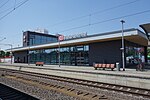Stadtkirche Wittenberg

The Stadt- und Pfarrkirche St. Marien zu Wittenberg (Town and Parish Church of St. Mary's) is the civic church of the German town of Lutherstadt Wittenberg. The reformers Martin Luther and Johannes Bugenhagen preached there and the building also saw the first celebration of the mass in German rather than Latin and the first ever distribution of the bread and wine to the congregation – it is thus considered the mother-church of the Protestant Reformation. In 1996, it was inscribed on the UNESCO World Heritage List along with Castle Church of All Saints (Schlosskirche), the Lutherhaus, the Melanchthonhaus, and Martin's Luther's birth house and death house in Eisleben, because of its religious significance and testimony to the lasting, global influence of Protestantism.
Excerpt from the Wikipedia article Stadtkirche Wittenberg (License: CC BY-SA 3.0, Authors, Images).Stadtkirche Wittenberg
Jüdenstraße,
Geographical coordinates (GPS) Address Nearby Places Show on map
Geographical coordinates (GPS)
| Latitude | Longitude |
|---|---|
| N 51.866833333333 ° | E 12.645055555556 ° |
Address
Kirchplatz
Jüdenstraße
06886 , Altstadt (Wittenberg)
Saxony-Anhalt, Germany
Open on Google Maps





